We would like to thank all those who came to our Study Group Meeting held on June 22nd in Osaka. We hope you were able to get lots of new ideas for your classes.
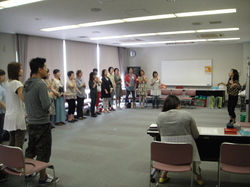 This is the report of the meeting.
This is the report of the meeting.
1. Warm Up Song
The session started with a fun song, “What do you like? What do you like to do?” to the tune of a famous children song, “Apples and Bananas”. In the original song, the verse “apples and bananas” changes to “/ei/pples and ban/ei/n/ei/s” and so on. With the OSG version, we changed the verse to the target sentence that we were to learn that day. We all had fun singing together. This kind of ‘kaeuta’ song will help your students remember sentence patterns easily. So please enjoy making your own songs. (Picture: Warm Up Song)
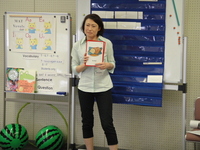 2. Practice Key 1
2. Practice Key 1
We demonstrated how to teach the sentence pattern, “What do you like? – I like ice cream.” By putting the cards in a pocket chart and showing them as a menu, the students enjoy thinking of the food they would really like to have. This will encourage students to get more interested in what they are going to learn and therefore learn better. Don’t forget to check the students’ pronunciation, too. We need to be careful with the sounds such as /r/ in “rice” because it does not exist in Japanese language. Also, we recommend using Japanese in checking the meaning of the target sentence. Although some people might think it is better to conduct the class all in English, we believe that this step is very important to avoid students’ learning gaps. It can be done by using flashcards with Japanese translation as well. Please try to do this in every lesson. (Picture: PK1)
3. It’s your turn 1
The participants got into small groups and took turns practicing the steps of the MAT METHOD. We also shared some of the problems we face in our lessons. For example, what could we do if there are some very energetic boys that sometimes get out of control? Or, how can we keep the 4 beat rhythm of the “Say it three times” part of the MAT Practice System? We shared comments and examined how to solve our problems and had a fruitful time learning from each other.
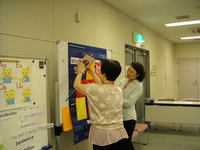 4. Practice Key 1 Activity
4. Practice Key 1 Activity
The games that we do in the lessons should be ones that give the students the most opportunities to speak. That is why we call these activities “Learning Activities.” The Memory Game is a common and handy activity that many teachers might already know. Students can use the language many times having fun, and the teachers will be able to do these games with little preparation. So this is indeed a very good “Learning Activity.” As a variation, we introduced a Tic-Tac-Toe Memory Game. It was a good challenge for all of us to try to remember which card was which.(Picture: PK1 Activity)
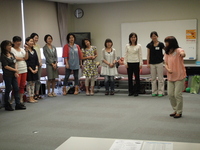 5. Practice Key 2
5. Practice Key 2
We introduced how to teach the sentence patterns, “What do you like to do? I like to swim.” The students have already learned the expression, “What do you like? I like ice cream.” So the point here was to contrast these two patterns and have the students notice the difference of the structure and the meaning of the sentences. Thus we can teach even the younger students that the difference depends on whether the following word is a ‘noun’ or a ‘verb’. By using the MAT METHOD and using the gestures, we can make this grammar point clear without using difficult grammar explanations. Also, using the Word Cards is very important and useful. It is always important to give visual hints as well as aural practice to avoid misunderstanding. (Picture: PK2-2)
6. It’s Your Turn 2
Here again we discussed and practiced the steps of the MAT METHOD as we taught the above sentence patterns. The most common question here was “When should we show the Word Cards?” Do you know the answer?
7. Practice Key 2 Activity
We enjoyed another “Learning Activity” using dice with six verb pictures. Everybody asks the question and the one who throws the die answers according to what the die shows. As a variation we used a die which has only the written words, play, eat and drink. The students have to add a suitable objective to the verb shown. In this way, they will learn to express more things in English!
8. Summer Activities and Songs
We really had fun singing and listening and making summer related crafts.
1) Story Telling “Watermelon Seed”
Oops! I swallowed a seed. What is going to happen to the seed inside me!! This is a cute story with a humorous ending. Please enjoy it with your students.
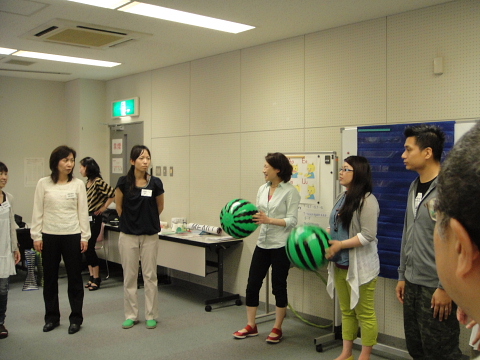 2) “Watermelon Song” and “Pass Watermelon balloons Game”
2) “Watermelon Song” and “Pass Watermelon balloons Game”
If you have the watermelon beach ball when the music stops, you have to answer to the question. Enjoy the thrill!!(Picture: Watermelon Beach ball)
3) Sing the Song, “Down by the Bay” and learn what rhyming is.
This song includes a lot of rhyming words such as “A goose kissing a moose”. Before singing this song, we tried rhyming words in Japanese.
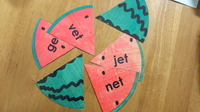 4) “Watermelon Phonics Game”
4) “Watermelon Phonics Game”
Read some 3 letter words and find those which belong to the same word family. If you get all the cards correctly, it should make a big whole watermelon!! (Picture: Watermelon Phonics Game)
5) “Carrying the Watermelon Game”
This is a game which can be enjoyed with a large number of children, including those who have not learned English yet. Teach the vocabulary of the body parts and you are ready to play. Throw a die and carry the watermelon colored balloon with your partner using your heads or shoulders and so on.
 6) Crafts
6) Crafts
This is a very easy but fun craft. It walks in a cute way. Have fun with your students. (Picture: Craft Penguins)
We are encouraged by the kind comments we receive from those who come to our meetings. Thank you very much.
We are looking forward to meeting you all at our next meeting!
IIEEC OSAKA
(IIEEC OSAKA Blog)